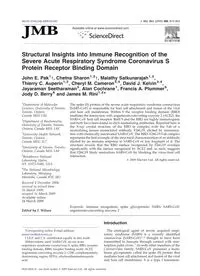
2009 Structural Insights into Immune Recognition of the Severe Acute Respiratory Syndrome Coronavirus S Protein Receptor PDF
Preview 2009 Structural Insights into Immune Recognition of the Severe Acute Respiratory Syndrome Coronavirus S Protein Receptor
Structural Insights into Immune Recognition of the Severe Acute Respiratory Syndrome Coronavirus S Protein Receptor Binding Domain John E. Pak1†, Chetna Sharon1,2†, Malathy Satkunarajah1,2, Thierry C. Auperin1,2, Cheryl M. Cameron3,4, David J. Kelvin3,4, Jayaraman Seetharaman5, Alan Cochrane1, Francis A. Plummer6, Jody D. Berry6 and James M. Rini1,2⁎ 1Department of Molecular Genetics, University of Toronto, Toronto, Ontario, Canada M5S 1A8 2Department of Biochemistry, University of Toronto, Toronto, Ontario, Canada M5S 1A8 3University Health Network, Toronto, Ontario, Canada M5G 1L7 4University of Toronto, Toronto, Ontario, Canada M5S 1A8 5Brookhaven National Laboratory, Upton, NY 11973-5000, USA 6The National Microbiology Laboratory, Winnipeg, Manitoba, Canada R3E 3R2 Received 4 December 2008; received in revised form 16 March 2009; accepted 16 March 2009 Available online 24 March 2009 The spike (S) protein of the severe acute respiratory syndrome coronavirus (SARS-CoV) is responsible for host cell attachment and fusion of the viral and host cell membranes. Within S the receptor binding domain (RBD) mediates the interaction with angiotensin-converting enzyme 2 (ACE2), the SARS-CoV host cell receptor. Both S and the RBD are highly immunogenic and both have been found to elicit neutralizing antibodies. Reported here is the X-ray crystal structure of the RBD in complex with the Fab of a neutralizing mouse monoclonal antibody, F26G19, elicited by immuniza- tion with chemically inactivated SARS-CoV. The RBD–F26G19 Fab complex represents the first example of the structural characterization of an antibody elicited by an immune response to SARS-CoV or any fragment of it. The structure reveals that the RBD surface recognized by F26G19 overlaps significantly with the surface recognized by ACE2 and, as such, suggests that F26G19 likely neutralizes SARS-CoV by blocking the virus–host cell interaction. © 2009 Elsevier Ltd. All rights reserved. Edited by I. Wilson Keywords: immune recognition; spike glycoprotein; SARS; SARS-CoV; angiotensin-converting enzyme 2 Introduction The etiological agent of severe acquired respi- ratory syndrome (SARS) is a recently identified coronavirus (SARS-CoV)1–4 thought to have been transmitted to humans through contact with mar- ketplace palm civets.5 As with other members of the Coronaviridae family, SARS-CoV possesses a mem- brane glycoprotein called the spike (S) protein that mediates host cell attachment and fusion of the viral and host cell membranes. S is a type I transmem- *Corresponding author. E-mail address:
